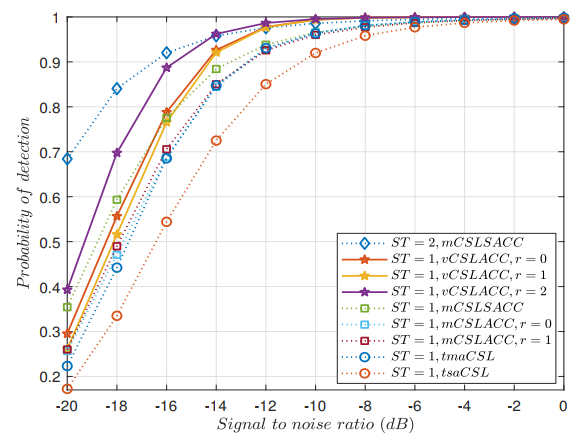[ Instrument R&D of Instrumentation Network ] Recently, the research team of Industrial Communication and System-on-Chip (iComSoC) of Shenyang Institute of Automation, Chinese Academy of Sciences has studied the perception function of next-generation smart radio and proposed the use of Multiple-Input, Multiple-Output , MIMO) system antenna cross-correlation and space-time information high-performance broadband spectrum sensing method, the relevant results have recently been published in the internationally renowned communication field IEEE Transactions on Communications.
Broadband Spectrum Sensing System Model Based on Antenna Cross-correlation Compressed Subspace Learning
The arrangement of two sets of sub-sampling samples: (a) matrix mode, (b) vector mode
Comparison chart of wideband spectrum sensing performance as a function of signal-to-noise ratio
With the continuous enrichment of wireless communication scenarios and the large-scale growth of wireless communication equipment and services, the available wireless spectrum resources are increasingly scarce, so it is crucial to study how to flexibly coordinate and fully utilize the limited spectrum resources of next-generation smart radio technology. Broadband spectrum sensing, as an important basic enabling technology for future smart radios, can enable wireless communication devices to have efficient electromagnetic environment sensing capabilities, dynamically coordinate each wireless communication device, and access unused spectrum resources for it, thereby increasing equipment And service access volume and improve spectrum efficiency provide a viable solution. In addition, the compressed subspace learning technology realizes the extraction of signal subspace by using a small number of sub-sampling samples. The introduction of this technology can greatly improve the broadband spectrum sensing performance. Although the related research has made great progress, the traditional broadband spectrum sensing technology based on compressed subspace learning mostly only considers the use of antenna autocorrelation information, so it faces the key problems of poor perception performance under low SNR conditions.
The iComSoC team of the Shenyang Institute of Automation introduced the antenna cross-correlation information of the multi-antenna system to the above key issues, and proposed a corresponding compressed subspace learning algorithm. By considering the spatial correlation MIMO channel model and the correlation matrix at the receiving end as an exponential correlation model, the team The analytical representation of the proposed algorithm and the traditional algorithm on the singular value relationship of the covariance matrix is ​​given. By deriving the gain over the singular value of the traditional algorithm (gain upper and lower bounds), the performance advantages of the proposed algorithm and the corresponding theoretical results are further revealed It can also be used to guide the selection of parameters in algorithms and the design of multi-antenna systems. This achievement provides an effective method for achieving highly reliable spectrum sensing of the next generation of smart radios, and published academic papers on the topic of Compressive subspace learning with antenna cross-correlations for wideband spectrum sensing.
In recent years, the iComSoC team has carried out certain research work on the cutting-edge scientific issues of perception and communication in the next-generation wireless communication system, put forward effective scientific methods, and achieved corresponding scientific research results. Several research achievements have been published by famous international journals such as IEEE's TCOM, TVT, SJ and so on. The team will further conduct in-depth research around the next-generation wireless communication related fields, and layer and structure the work.
(Original title: Progress in Intelligent Radio Broadband Spectrum Sensing Research at Shenyang Automation Institute)
What is Feeder on the placement machine? What is Feida on the placement machine? Feida is the main accessory of the placement machine. Its function is to mount the SMD patch components on the feeder, and the feeder provides components for the placement machine for patching.
In the placement machine, the feeder functions to supply the chip component SMC/SMD to the placement head in a regular pattern and order for accurate and convenient pickup, which occupies a large number and position in the placement machine. It is also an important part of choosing a placement machine and arranging the placement process. Depending on the SMC/SMD package, feeders typically have a variety of tapes, sticks, waffles, and bulk materials.
Tape feeders with the different size such as 8mm, 16mm, 24mm, 32mm, 44mm, 56mm etc.
Panasonic Feeder
Panasonic Feeder,Insertion Machine Tape Feeder Unit,Tape Feeder Unit,Feeder Panasonic
Shenzhen Keith Electronic Equipment Co., Ltd. , https://www.aismtks.com


